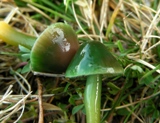|
|
|
|
|
Galleria Tassonomica
di
Natura Mediterraneo
|
|
|
| Autore |
 Discussione Discussione  |
|
|
ciuppy
Utente Senior
   
Città: bibbiano
Prov.: Reggio Emilia
Regione: Emilia Romagna

4418 Messaggi
Tutti i Forum |
|
|
paoli
Moderatore
   

Città: Castelnuovo Garfagnana
Prov.: Lucca
Regione: Toscana

2784 Messaggi
Tutti i Forum |
 Inserito il - 22 settembre 2008 : 22:33:53 Inserito il - 22 settembre 2008 : 22:33:53


|
Probabile Stropharia squamosa (Pers.:Fr) Quèlet
Ciao, Maurizio.
"i dilettanti hanno costruito l'arca, i professionisti il Titanic"...anonimo... |
 |
|
|
giancarlo
Moderatore
   
Città: Perugia
Prov.: Perugia
Regione: Umbria

3025 Messaggi
Micologia |
 Inserito il - 23 settembre 2008 : 14:47:08 Inserito il - 23 settembre 2008 : 14:47:08


|
ciao
sono d'accordo con Paoli
un saluto
giancarlo |
 |
|
|
Ennio Carassai
Moderatore
   
Città: Macerata
Prov.: Macerata
Regione: Marche

1851 Messaggi
Micologia |
 Inserito il - 23 settembre 2008 : 15:11:21 Inserito il - 23 settembre 2008 : 15:11:21


|
probabilmente penso anch'io sia lei,
anche se l'anello mediano, ricorda più una Pholiotina aporus,
un saluto,
Ennio, |
Modificato da - Ennio Carassai in data 23 settembre 2008 15:14:42 |
 |
|
|
mauretto
Moderatore
   

Città: pergine valsugana
Prov.: Trento
Regione: Trentino - Alto Adige

4540 Messaggi
Micologia |
 Inserito il - 23 settembre 2008 : 15:46:05 Inserito il - 23 settembre 2008 : 15:46:05


|
Scusate, faccio a tutti una domanda.
Controllando raffronti fotografici e descrittivi in rete, mi sono imbattuto in chi, dopo panalisi micro, afferma che a suo parere visti i caratteri il fungo potrebbe essere collocato a pieno diritto nel genere Psilocybe.
Vado a controllare su index fungorum (ache se non sono sicuro di saperlo utilizzare correttamente) e trovo che, secondo "lui", il nome corretto dovrebbe essere Leratiomyces squamosus (Pers.) Bridge & Spooner
Allego il link: Link
è corretto ciò che dico o faccio casino come al solito?  |
 |
|
|
Lipo
Utente Senior
   

Città: Desio
Prov.: Milano
Regione: Lombardia

3330 Messaggi
Micologia |
 Inserito il - 23 settembre 2008 : 19:56:15 Inserito il - 23 settembre 2008 : 19:56:15


|
| Messaggio originario di Ennio Carassai:
probabilmente penso anch'io sia lei,
anche se l'anello mediano, ricorda più una Pholiotina aporus,
un saluto,
Ennio,
|
Ciao Ennio, troppo massiccia, comparala con le foglie di faggio e anche il colore della sporata non coinciderebbe.
Per il suo nome attuale dovremmo chiederlo ad Alfredo
Luigi
|
 |
|
|
Andrea
Utente Senior
   

Città: ROMA
Prov.: Roma
Regione: Lazio

2764 Messaggi
Tutti i Forum |
 Inserito il - 09 ottobre 2008 : 13:52:33 Inserito il - 09 ottobre 2008 : 13:52:33


|
Salute a tutti,
per il momento la specie viene inserita nell'archivio dei taxa come Stropharia squamosa.
In attesa di autorevoli pareri, può essere interessante la lettura di questo recente articolo (purtroppo, in lingua inglese), tratto dal sito
Link
| Hey Man, Do they grow any Weraroa around here?
© Peter Werner
Original publication: Mycena News, September 2008
One of the most common complaints that amateur mycologists have about academic mycology is the frequency of changes in the scientific names of fungi. These changes reflect the state of flux that the taxonomy of organisms of all types is undergoing due to advances in molecular phylogenetics. However, they also reflect applications of the rules of nomenclature that have been devised to make sure scientific names of organisms reflect the actual evolutionary relationships rather than arbitrary categories. Some recent discoveries concerning relationships among genera in the Strophariaceae underline how a few discoveries can set off a cascade of renaming genera and species.
The major guideline for modern taxonomy is that classification into a particular group should reflect real descent from a common ancestor. A real taxonomic group should include all the descendents of a single ancestral species, and no species that are not descended from that ancestor. Such a group (or “clade,” in phylogenetic terminology) is said to be “monophyletic.” Other groupings that include some, but not all, descendents of a common ancestor, or groups of species that do not include a common ancestor for all members, are viewed as artificial and do not reflect evolutionary reality.
Ideally, the notion that the name of an organism should reflect real monophyletic clades seems like a simple enough rule. However, scientific taxonomy by its very nature is something that generates lots of names, and this is where it gets complicated—how does one judge what the “right” name is for a particular taxon? There are several principles that guide this and, ironically enough, were devised to promote the idea of “nomenclatural stability”—that is, to prevent scientific names from being changed capriciously.
An important core rule is the Principle of Priority. This is the idea that, once an organism has been given a scientific name, that name remains the sole valid name for that taxon. Organisms may be moved into and out of the taxon, but the oldest name takes priority as long as that group remains as a real entity. The idea behind this is to prevent capricious renaming—that is, later scientists using a new name of their own to replace an already-named taxon. The only ways that an older group can be renamed is (1) its Linnean rank changes, for example, if a group classified as a “family” was reclassified as an “order” in a new system (and even then, the older family name would be expected to be conserved somewhere within that order); (2) the older name was not validly published (the International Code of Botanical Nomenclature is quite strict about what constitutes valid publication of a taxonomic name); or (3) by special decision: the ICBN committee makes a formal ruling to conserve a more recent name against an older one.
Another important rule is the “type” concept. This means that any named species should have a type collection to which the species name is attached. (Though this is not always the case with species named prior to the twentieth century.) If a single species ends up being divided into multiple species, the species that contain the original type collection bear the older species name. A “type species” is the species to which the name of a taxon of the rank of family or smaller (that is, a family, genus, or groups within a genus) is attached. So if a single family or genus is divided into several families or genera, the group that contains the type species keeps the older name.
While this system is supposed to keep scientific names relatively stable, it sometimes has the effect of leading to dramatic and unexpected name changes in light of new taxonomic discoveries. This is nowhere more evident than in some of the names changes that are taking place within the Strophariaceae.
This began with the discovery by Moncalvo and others (2002) that Psilocybe was a paraphyletic group, an artificial assemblage of two distinct clades. Basically, the hallucinogenic blue-staining group, for which Psilocybe is best known, is not directly related to the more innocuous non-hallucinogenic Psilocybe; and that furthermore, it was this later group that the type species of Psilocybe, P. montana, fell into, and hence was the group that was most properly named Psilocybe.
A paper by Metheny and others (2006) that contained a very well-supported molecular phylogeny of the Agaricales confirmed the findings about Psilocybe in the Moncalvo paper and added a few other interesting twists. The Strophariaceae and their closest relatives were assembled into two families, the Strophariaceae and the Hymenogastraceae. The latter group bears an old family name that was thought to apply only to a small group of false truffles, but that were now found to be well embedded within a larger group of mostly above-ground mushrooms. The Strophariaceae was defined as including its traditional genera of Stropharia, Hypholoma, Pholiota, and the non-bluing Psilocybe, plus the addition of Agrocybe, which was found to be ensconced within this group. The Hymenogastraceae were found to include Galerina, Phaeocollybia, Alnicola, and Hymenogaster, among others, and also the bluing “Psilocybe” that were clearly shown to be a sister group to Galerina.
Formal renaming of the bluing psilocybe has been postponed until a more thorough molecular phylogeny that includes many more species has taken place. Nonetheless, it is expected that such a survey will be consistent with what has found so far in the Moncalvo and Metheny papers. There has also been much speculation as to what the “magic mushroom” psilocybe might be called. A survey of scientific names and synonyms among the bluing psilocybe does not seem to reveal any older available name, which the Principle of Priority would dictate be used for this group.
A recent phylogeny of stropharioid fungi by Bridge and others (2008) suggests an intriguing possibility. This paper further confirms the findings of the Moncalvo and Metheny papers, and finds that the type species of the secotioid (“stalked puffball”) genus Weraroa, W. novaezelandiae, is well-embedded within the bluing Psilocybe and a close relative of the downunder “magic mushroom,” P. subaeruginosa. This makes perfect sense, as this species is itself strongly blue-staining (presumably containing psilocin and psilocybin) and, once one gets beyond its odd secotioid appearance, it is very similar to other bluing Psilocybe. Taking note of the concepts of type and priority, the implications of this are clear: unless a thorough search of obscure mycological literature turns up an older available name, the proper name for the bluing psilocybe is Weraroa!
This is not the only big nomenclatural implication of this paper. Although the paper does not formally rename the bluing Psilocybe as Weraroa, it reclassifies the majority of other species of Weraroa into a new genus within the Strophariaceae, Leratiomyces. Hence, the name Weraroa, does not really apply to most of the species we know as Weraroa.
The expansion of the genus Leratiomyces likewise has some rather large implications. This was originally a small genus of secotioid species found in New Caledonia, but has now been found to include the former Stropharia section Stropholoma (including Stropharia (= Hypholoma) aurantiaca, S. riparia—a name used for at least two species on the West Coast, and S. squamosa) and most of the species of Weraroa (though not the type species). Furthermore, Stropharia aurantiaca, which may already hold some sort of record for name changes, has undergone a double name change to Leratiomyces ceres, having been found not only to fall into Leratiomyces, but was also found to be identical to the older Stropharia ceres, hence, having that species name take priority.
So, in summary, it seems the best-known Psilocybe may possibly be called Weraroa, the best-known Weraroa have been renamed Leratiomyces, and one of our most common wood chip fungi has gone from Stropharia aurantiaca (or, if you prefer, Hypholoma or Naematoloma aurantiacum) to Leratiomyces ceres. What’s the beleaguered amateur to do? Perhaps a system of standardized common English names may be the answer, but this is no small irony, as the use of Latin scientific names was supposed to standardize “unstable” common names.
Further reading
Matheny PB, et al. 2006. Major clades of Agaricales: a multilocus phylogenetic overview. Mycologia 98:982–995. Available from the Hibbett Lab as a PDF file.
Moncalvo JM, et al. 2002. One hundred and seventeen clades of euagarics. Molecular Phylogenetics and Evolution 23:357–400. Available from the Moncalvo Lab as a PDF file.
Bridge PD, Spooner B, Beever RE, Park D-C. 2008. Taxonomy of the fungus commonly known as Stropharia aurantiaca with new combinations in Leratiomyces. Mycotaxon 103:109–121. |
Andrea
In una notte senza luna o stelle non si riesce a vedere nulla, ma si può immaginare tutto.
C. Palahniuk
|
 |
|
| |
 Discussione Discussione  |
|
|
|
 Natura Mediterraneo Natura Mediterraneo |
© 2003-2024 Natura Mediterraneo |
 |
|
Leps.it | Herp.it | Lynkos.net
|

 Forum
|
Registrati
|
Msg attivi
|
Msg Recenti
|
Msg Pvt
|
Utenti
|
Galleria |
Map |
Forum
|
Registrati
|
Msg attivi
|
Msg Recenti
|
Msg Pvt
|
Utenti
|
Galleria |
Map |